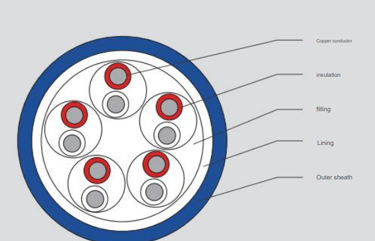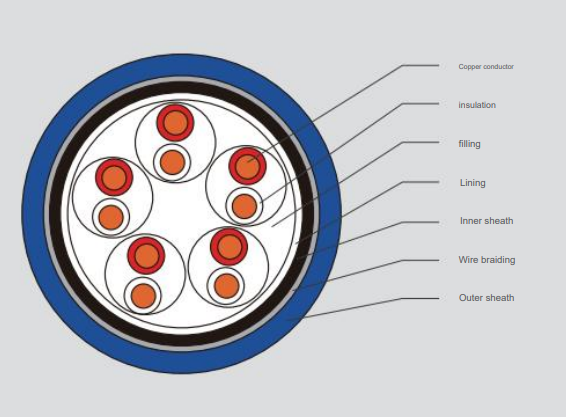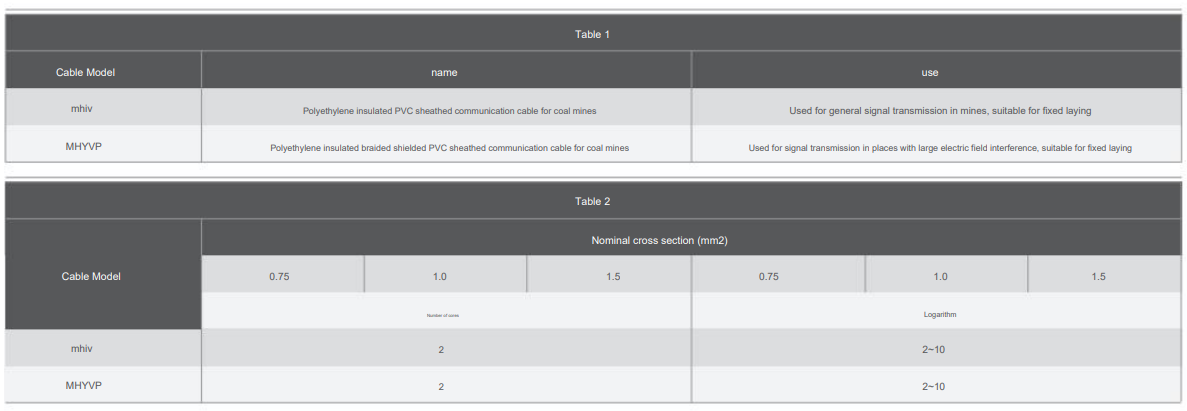Understanding MHYV and MHYVP Communication Cables: Essential Infrastructure for Safe Coal Mining Operations
Comprehensive guide to MHYV and MHYVP communication cables for coal mines, covering technical specifications, applications, installation requirements, and safety standards for reliable underground signal transmission.
6/5/20258 min read
Understanding MHYV and MHYVP Communication Cables: Essential Infrastructure for Safe Coal Mining Operations
Introduction: The Critical Role of Communication in Underground Mining
In the depths of coal mines, where darkness prevails and danger lurks around every corner, communication systems serve as lifelines that connect workers to safety and operational efficiency. Among the most crucial components of these communication networks are specialized cables designed to withstand the harsh underground environment while maintaining reliable signal transmission. Two such cables that have become industry standards are the MHYV and MHYVP communication cables, engineered specifically for coal mining applications.
These cables represent decades of engineering refinement, combining materials science with practical mining experience to create communication infrastructure that can operate reliably in some of the world's most challenging industrial environments. Understanding their capabilities, applications, and proper implementation is essential for mining engineers, safety professionals, and anyone involved in underground operations.
MHYV and MHYVP cables are not merely communication lines; they are sophisticated engineered systems that must balance multiple demanding requirements simultaneously. They must resist moisture, temperature extremes, mechanical stress, and electrical interference while maintaining crystal-clear signal transmission that can mean the difference between efficient operations and catastrophic failure.
Fundamental Design Philosophy and Construction
The development of MHYV and MHYVP cables follows a design philosophy centered on reliability in extreme conditions. Think of these cables as the nervous system of a coal mine, carrying vital information throughout the underground network much like nerves carry signals throughout the human body. Just as our nervous system must function reliably regardless of external conditions, these cables must maintain their performance whether subjected to flooding, temperature variations, or mechanical stress.
The MHYV cable represents the foundational communication solution for coal mines. Its construction begins with a polyethylene insulation system that provides excellent electrical properties while resisting moisture absorption. This insulation surrounds carefully engineered conductors designed to maintain their electrical characteristics over long installation periods. The outer PVC sheath provides mechanical protection and additional moisture resistance, creating a robust barrier against the underground environment.
The MHYVP cable builds upon this foundation by incorporating a braided shielding layer between the insulated conductors and the outer sheath. This shielding serves as an electromagnetic barrier, much like a Faraday cage, protecting the signal-carrying conductors from external electrical interference. In mining environments where large electrical equipment operates continuously, this shielding becomes essential for maintaining signal integrity.


Technical Specifications and Performance Characteristics
Understanding the technical specifications of these cables requires examining how each component contributes to overall performance. The conductor structures available in these cables are carefully engineered to balance electrical performance with mechanical flexibility and durability.
For the smallest cross-sectional area of 0.75 mm², manufacturers offer two conductor configurations. The single-strand construction (1/0.97 mm) provides the lowest electrical resistance but offers limited flexibility. The seven-strand construction (7/0.37 mm) distributes mechanical stress across multiple smaller conductors, improving durability while maintaining acceptable electrical performance with a maximum DC resistance of 24.5 Ω/km at 20°C.
The 1.0 mm² conductors similarly offer both single-strand (1/1.13 mm) and multi-strand (7/0.43 mm) options, both maintaining a maximum DC resistance of 18.1 Ω/km. This consistency in electrical performance between construction types allows engineers to select based on mechanical requirements while maintaining predictable electrical characteristics.
The largest standard size, 1.5 mm², provides the lowest resistance at 12.1 Ω/km maximum, available in both single-strand (1/1.38 mm) and seven-strand (7/0.52 mm) configurations. This size typically serves longer communication runs or applications requiring higher current capacity.








Applications and Environmental Considerations
The choice between MHYV and MHYVP cables depends primarily on the electromagnetic environment where they will operate. In areas of the mine with minimal electrical interference, such as administrative areas or zones with limited heavy equipment, MHYV cables provide reliable, cost-effective communication solutions. These areas might include mine offices, storage areas, or sections where only lighting and basic ventilation equipment operate.
MHYVP cables become essential in electrically noisy environments. Consider areas near large motors, variable frequency drives, or high-power electrical distribution equipment. In these locations, electromagnetic fields can induce unwanted signals in unshielded communication cables, causing static, cross-talk, or complete signal loss. The braided shielding in MHYVP cables creates an electromagnetic barrier that prevents these external fields from affecting the communication signals.
Both cable types are designed for fixed installations, meaning they are intended for permanent mounting using appropriate cable support systems. This distinguishes them from portable or flexible cable types that might be used for temporary installations or equipment that requires frequent repositioning.
Operating Environment and Performance Limits
Coal mines present unique environmental challenges that these cables must overcome. Temperature variations can be extreme, ranging from near-freezing conditions in some sections to elevated temperatures near equipment or in deeper workings. Both MHYV and MHYVP cables are engineered to maintain their electrical and mechanical properties across a temperature range of -40°C to +50°C.
Humidity control in underground mines is often challenging, with some areas experiencing near-saturated conditions. These cables are designed to function effectively in environments with up to 95% relative humidity at 25°C. This capability results from careful material selection and construction techniques that prevent moisture ingress while allowing the cable to breathe and prevent internal condensation.
The mechanical environment in mines subjects cables to various stresses including vibration from equipment, settling of rock formations, and occasional impact from mining activities. The PVC outer sheath provides excellent mechanical protection while maintaining flexibility for installation around corners and through confined spaces.
Installation Considerations and Best Practices
Proper installation of MHYV and MHYVP cables requires understanding both the electrical and mechanical aspects of the underground environment. Cable routing should consider potential sources of mechanical damage, electromagnetic interference, and accessibility for future maintenance or system expansion.
When installing MHYVP cables, the shielding effectiveness depends on proper grounding techniques. The braided shield must be connected to a reliable ground system at appropriate intervals to ensure effective electromagnetic protection. Improper shield grounding can actually worsen interference problems by creating ground loops or allowing the shield to act as an antenna rather than a barrier.
Cable support systems must account for the weight of the installed cable plus any dynamic loads from thermal expansion, vibration, or settling. Support spacing should follow manufacturer recommendations while considering local conditions that might require closer spacing in areas subject to unusual mechanical stress.

Frequently Asked Questions About MHYV and MHYVP Cables
What is the primary difference between MHYV and MHYVP cables?
The fundamental difference lies in electromagnetic interference protection. MHYV cables consist of polyethylene-insulated conductors within a PVC outer sheath, suitable for general communication applications in electrically quiet environments. MHYVP cables add a braided metallic shielding layer between the conductors and outer sheath, providing electromagnetic interference protection essential in areas with significant electrical equipment operation. Think of the difference like comparing a regular telephone wire to a high-quality audio cable with shielding—both carry signals, but the shielded version prevents interference that could disrupt communication quality.
Can these cables be used in flexible installations or only fixed ones?
Both MHYV and MHYVP cables are specifically designed for fixed installations where the cable remains stationary after installation. Their construction prioritizes long-term reliability and environmental resistance over flexibility. For applications requiring cable movement, such as portable equipment or drag chains, specialized flexible cable types like MHYVR or MHYVRP should be used instead. Using fixed-installation cables in flexible applications would likely result in premature failure due to conductor fatigue and insulation degradation from repeated bending.
What are the operating temperature ranges for these cables?
These cables maintain their electrical and mechanical properties within a temperature range of -40°C to +50°C. This wide operating range accommodates the extreme temperature variations possible in underground mining environments, from near-freezing conditions in some mine sections to elevated temperatures near heavy equipment or in deeper workings. The materials used in construction—polyethylene insulation and PVC sheathing—are specifically chosen for their stable properties across this temperature range.
Are these cables resistant to moisture and humidity?
Yes, both cable types are engineered to function effectively in high-humidity environments up to 95% relative humidity at 25°C. This moisture resistance results from the combination of polyethylene insulation, which has excellent moisture resistance properties, and the PVC outer sheath, which provides an additional moisture barrier. However, proper installation practices including appropriate sealing of cable entry points and proper drainage in cable trays remain important for long-term reliability.
What standards do these cables comply with?
These cables adhere to the MT818.14-1999 standard, which specifically addresses communication cables for mining applications. This standard encompasses safety requirements, performance specifications, and testing procedures relevant to underground mining environments. Compliance with this standard ensures that the cables meet the specific safety and performance requirements necessary for reliable operation in coal mining applications, including flame resistance, mechanical durability, and electrical performance criteria.
How do I determine the appropriate conductor size for my application?
Conductor size selection depends on several factors including transmission distance, signal type, and current requirements. For longer cable runs or applications requiring lower signal loss, larger conductor cross-sections (1.5 mm²) provide lower DC resistance. For shorter runs or low-power applications, smaller conductors (0.75 mm²) may be adequate and more cost-effective. Additionally, consider future expansion needs and standardization with existing installation practices when making this selection.
What is the maximum number of conductor pairs available?
Both MHYV and MHYVP cables are available with 2 to 10 conductor pairs, allowing system designers to select the appropriate capacity for their specific communication requirements. Multi-pair cables can serve multiple communication circuits or provide redundancy for critical communication links. When planning installations, consider both current requirements and potential future expansion to avoid costly cable replacement later.
Can these cables be spliced or joined during installation?
While these cables can be spliced using appropriate techniques and materials, splicing should be minimized to maintain system reliability. Each splice point represents a potential failure location and may introduce signal degradation. When splicing is necessary, use only approved splicing techniques and materials designed for the specific cable type and environmental conditions. For MHYVP cables, particular attention must be paid to maintaining shield continuity across splice points.
Conclusion: Ensuring Reliable Communication Infrastructure
MHYV and MHYVP communication cables represent essential infrastructure components that enable safe and efficient coal mining operations. Their specialized design addresses the unique challenges of underground environments while providing reliable signal transmission capabilities that mining operations depend upon for both routine communication and emergency situations.
The selection between MHYV and MHYVP cables should be based on a thorough assessment of the electromagnetic environment, with MHYVP cables chosen for areas with significant electrical interference and MHYV cables suitable for general applications. Understanding the technical specifications, environmental limitations, and proper installation practices ensures these communication systems will provide years of reliable service in the demanding underground mining environment.
As mining operations continue to evolve with advancing technology and increasing safety requirements, the role of reliable communication infrastructure becomes ever more critical. These specialized cables, when properly selected and installed, form the foundation upon which modern mine communication systems are built, contributing to both operational efficiency and worker safety in one of the world's most challenging industrial environments.


